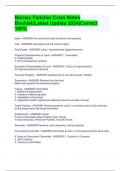Essay
(English9ELO) Boredom and Excitement in The Great Gatsby (chapter 1)
- Institution
- PEARSON (PEARSON)
- Book
- The Great Gatsby
This document answers the question "How does F. Scott Fitzgerald create an atmosphere of boredom and excitement in ‘The Great Gatsby’? (Chapter 1)" Pearson Edexcel AS & A Level English Language & Literature Chapter 1 of ‘The Great Gatsby’ Society and the Individual Varieties in Language...
[Show more]













